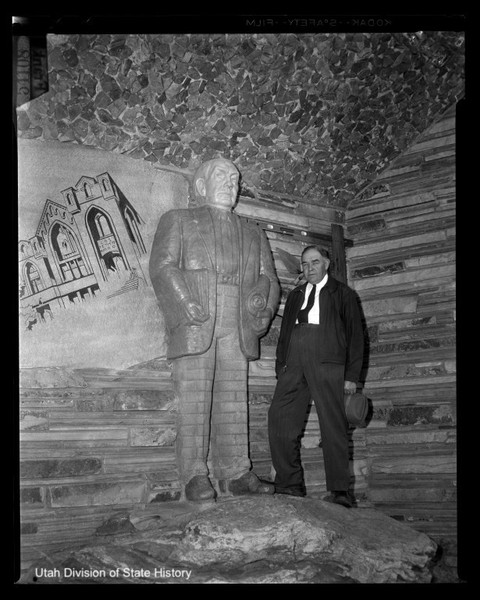Dublin Core
Title
Description
Hidden in the Trolley Square neighborhood in downtown Salt Lake City is a 3-acre public park called Gilgal Sculpture Garden. In this outdoor art gallery you’ll find philosophical and religious concepts etched into 12 hand-carved sculptures and 70 engraved stone slabs – including the face of LDS Church founder Joseph Smith on a sphinx. This truly unique garden is an example of what art historians call a “visionary art environment” and is a testament to the power of community preservation in Salt Lake City.
Visionary art environments are places where a single artist gives physical form to abstract ideas about morals, spirituality, and philosophy. Started in 1945, Gilgal was designed and built by Thomas Battersby Child Jr., a highly respected masonry contractor and longtime bishop of the LDS 10th Ward. Naming his garden after a location in the Old Testament, Child wanted to create a space that felt mysterious and thought-provoking, full of Biblical references, quotes from literature and poems, and even abstract imagery. His self-portrait speaks to his identity as both a stone mason and a Mormon, showing a man wearing brick pants, holding a copy of the Bible in one hand and blueprints in the other.
“You may think I am a nut,” Child said of designing the garden, “but I hope I have aroused your thinking and curiosity.” Child went to great lengths to obtain the stones for his garden, visiting Utah canyons and streams to find the perfect rock. He had a complete workshop in his yard for handling and cutting the stone. Many of the rock sculptures have a glistening, shiny quality because of the technique Child developed with his son-in-law while creating Gilgal, using a steel cutting torch instead of the traditional chisel and hammer.
After Child’s death in 1963, his widow sold the property and it was eventually rezoned to allow the development of condominiums. In 1997, a group of community members formed the Friends of Gilgal Garden and raised $679,000 to purchase the property. They donated the garden to the city of Salt Lake in 2000, and still work to preserve Child’s stone sculptures for generations to come.
Creator
Source
_______________
See Pamela Manson, “Gilgal Garden celebrates 10 years as a public park,” Salt Lake Tribune, September 13, 2010; “Wirth Watching: History of Salt Lake City's Gilgal Gardens,” ABC4News, October 11, 2021;“About Gilgal,” Gilgal Sculpture Garden, accessed November 2022; Laura Chynoweth, “Gilgal Gardens,”Utah Stories, July 10, 2015; “Gilgal,” Church of Jesus Christ of Latter-Day Saints, accessed November, 2022; Kathy Stephenson, “Salt Lake City’s Gilgal Sculpture Garden earns honor from national historic group,” Salt Lake Tribune, July 11, 2020; Gilgal Sculpture Garden website, accessed November 26, 2022.

